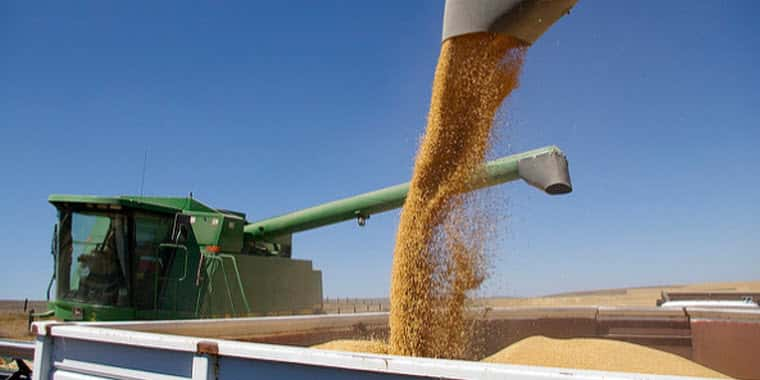Agriculture Secretary Tom Vilsack announced that the U.S. Department of Agriculture (USDA) is providing $2.3 billion to help American producers maintain and develop markets for their commodities and use U.S. commodities to bolster international food aid.
Consistent with a bipartisan request from the Senate Committee on Agriculture, Nutrition, and Forestry, USDA is utilizing funds from the Commodity Credit Corporation (CCC) to address challenges related to trade and food insecurity impacting U.S. farmers and the international community. USDA will use:
- $1.3 billion for the Regional Agricultural Promotion Program and support for specialty crop industries to diversify export markets.
- $1 billion to help address global hunger.
“The Commodity Credit Corporation continues to address the needs of American producers as significant and unpredictable challenges arise, including impacts to international commodities markets and global food insecurity in the wake of ongoing conflict and a changing climate,” said Secretary Vilsack. “The Commodity Credit Corporation and USDA’s market development and aid programs are critically important at this time, and with this additional support we can strengthen U.S agriculture’s presence in existing markets, open up new market opportunities, and build on our relationships and connections to ensure that high-quality American agriculture and food products reach where they are needed in the world.”
Regional Agricultural Promotion Program
The FY23 agricultural trade deficit is $19 billion, and USDA has projected that it will grow to $27.5 billion in FY24. There is also increased competition in our export markets in Asia and Africa. Therefore, additional investments in market development need to be made to keep ahead of the competition. Analysis has shown that for every $1 invested in export market development, exports are increased by $24.50. Increased agricultural exports means income directly back to producers. Trade promotion investment helps keep existing markets open and creates access to new markets. Further, investing in non-traditional markets will help the United States diversify away from dependence on a handful of large markets.
The new $1.3 billion investment in a Regional Agricultural Promotion Program, or RAPP, will enable exporters to break into new markets and increase market share in growth markets. Further, an investment in providing targeted technical assistance to the specialty crops industry will help it enter and expand markets that often impose onerous non-tariff barriers on their products. Five years ago, in reaction to the trade war with China, USDA developed the Agricultural Trade Promotion Program (ATP) to help exporters diversify their markets. The funds from ATP will expire next year and with that, many exporters are already curtailing their activities. Without being on the ground in markets, it is nearly impossible to build the trust and relationships needed to create opportunities. The RAPP will address this critical loss and ensure continuity of the relationships key to market development.
International Food Aid
Recent challenges to supply chains and on-going conflicts have exacerbated what was already a dire situation of increased numbers of people experiencing food insecurity globally. An estimated 205 million people need life-saving food assistance, and some 768 million people are facing chronic hunger, according to the Global Report on Food Crises and FAO. American agriculture is well positioned to help fill these gaps. The United States produces more commodities than are consumed, and therefore has the opportunity to extend this food, via a USDA donation, to those who are in need.
USDA will purchase commodities and work with USAID, who is the lead federal agency on international emergency food aid programs, to ensure they reach those most in need around the world. The $1 billion donation will bolster ongoing efforts to address global hunger, as well as support U.S. agriculture through the purchase of surplus commodities. U.S. agriculture stakeholders are eager to assist in addressing hunger that continues in some areas of the world due to conflict, droughts and other challenges. Given the exceptionally high food needs around the world at this time, these additional commodities will fill critical resource gaps.
Industry Response
“Additional funding for food assistance programs will help address the most urgent humanitarian needs in a generation. USW and NAWG look forward to working with USDA and other partners to ensure additional food donations generate the most benefit where it is needed most,” said National Association of Wheat Growers President Brent Cheyne. “As NAWG works with Congress to reauthorize the Farm Bill, we continue to advocate for strengthening the in-kind commodity donation program and additional investments in the existing trade promotion programs.”
“USW demonstrated that the additional funding helped us protect crucial wheat export sales in established markets and build a base for growth in new markets,” said U.S. Wheat Associates Chairman and Oklahoma wheat farmer Michael Peters. “We appreciate the introduction of the new Regional Agricultural Promotion Program (RAPP), and the USW team will work very hard to use it effectively. Looking ahead, global wheat trade is increasingly competitive and market development takes time and consistency. That’s why we believe that in the long-term, increases for established Farm Bill export development programs are the best way forward.”
Dan Halstrom, president and CEO of the U.S. Meat Export Federation, also thanked Vilsack and his staff for prioritizing international market development. Halstrom also listed the various trade programs that have helped agriculture overcome trade barriers in recent years. “With ATP funding coming to the end, new investments in foreign market development are very timely and much appreciated,” Halstrom said. “We also thank Congressional leaders for their support of this program and for their continued support of MAP and FMD funding.”
###
USDA/NAWG/USMEF/USW




